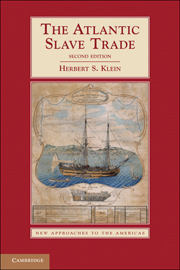Book contents
- Frontmatter
- Contents
- List of Maps, Figures, and Tables
- 1 Major slave-trading zones of western Africa
- 2 Major slave-trading ports of Senegambia and Sierra Leone
- 3 Major slaving ports of the Gold Coast and the Bights of Benin and Biafra
- 4 Major slaving ports of southwestern and southeastern Africa
- Introduction
- 1 Slavery in Western Development
- 2 American Labor Demand
- 3 Africa at the Time of the Atlantic Slave Trade
- 4 The European Organization of the Slave Trade
- 5 The African Organization of the Slave Trade
- 6 The Middle Passage
- 7 Social and Cultural Impact of the Slave Trade on America
- 8 The End of the Slave Trade
- Appendix
- Bibliographic Essay
- Index
8 - The End of the Slave Trade
Published online by Cambridge University Press: 05 June 2012
- Frontmatter
- Contents
- List of Maps, Figures, and Tables
- 1 Major slave-trading zones of western Africa
- 2 Major slave-trading ports of Senegambia and Sierra Leone
- 3 Major slaving ports of the Gold Coast and the Bights of Benin and Biafra
- 4 Major slaving ports of southwestern and southeastern Africa
- Introduction
- 1 Slavery in Western Development
- 2 American Labor Demand
- 3 Africa at the Time of the Atlantic Slave Trade
- 4 The European Organization of the Slave Trade
- 5 The African Organization of the Slave Trade
- 6 The Middle Passage
- 7 Social and Cultural Impact of the Slave Trade on America
- 8 The End of the Slave Trade
- Appendix
- Bibliographic Essay
- Index
Summary
If the slave trade was profitable and the Africans were put to productive use in the Americas, then why did Europeans begin to attack the trade at the end of the eighteenth century and systematically terminate the participation of every European metropolis and American colony or republic in the nineteenth century? Most economists now seem to agree that the organization of American plantation slave labor guaranteed that this system of labor was profitable to the planters and slave owners. Moreover, prices of slave-produced American goods fell over the course of the late eighteenth and early nineteenth centuries, with the result that consumption of those products was expanding at a rapid rate. The elastic demand for sugar, coffee, and cotton, the three major slave-produced crops of America, produced profits for the planter class. Nor could any free workers, except for some indentured Chinese or part-time peasants, be found who would work under these plantation systems. The question then remains as to why the trade was finally abolished if it was still profitable and important to the American economy.
It is now believed that the campaign to abolish the Atlantic slave trade, which began in the last quarter of the eighteenth century, was the first peaceful mass political movement based on modern types of political propaganda in English history. The early literature viewed this campaign as a moral crusade that was achieved at the cost of profits and trade.
- Type
- Chapter
- Information
- The Atlantic Slave Trade , pp. 188 - 212Publisher: Cambridge University PressPrint publication year: 2010

